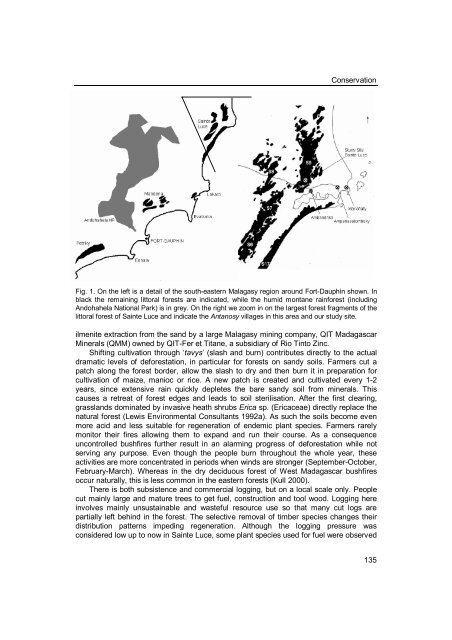Fruit-frugivore interactions in a Malagasy littoral forest - Universiteit ...
Fruit-frugivore interactions in a Malagasy littoral forest - Universiteit ...
Fruit-frugivore interactions in a Malagasy littoral forest - Universiteit ...
You also want an ePaper? Increase the reach of your titles
YUMPU automatically turns print PDFs into web optimized ePapers that Google loves.
Conservation<br />
Fig. 1. On the left is a detail of the south-eastern <strong>Malagasy</strong> region around Fort-Dauph<strong>in</strong> shown. In<br />
black the rema<strong>in</strong><strong>in</strong>g <strong>littoral</strong> <strong>forest</strong>s are <strong>in</strong>dicated, while the humid montane ra<strong>in</strong><strong>forest</strong> (<strong>in</strong>clud<strong>in</strong>g<br />
Andohahela National Park) is <strong>in</strong> grey. On the right we zoom <strong>in</strong> on the largest <strong>forest</strong> fragments of the<br />
<strong>littoral</strong> <strong>forest</strong> of Sa<strong>in</strong>te Luce and <strong>in</strong>dicate the Antanosy villages <strong>in</strong> this area and our study site.<br />
ilmenite extraction from the sand by a large <strong>Malagasy</strong> m<strong>in</strong><strong>in</strong>g company, QIT Madagascar<br />
M<strong>in</strong>erals (QMM) owned by QIT-Fer et Titane, a subsidiary of Rio T<strong>in</strong>to Z<strong>in</strong>c.<br />
Shift<strong>in</strong>g cultivation through ‘tavys’ (slash and burn) contributes directly to the actual<br />
dramatic levels of de<strong>forest</strong>ation, <strong>in</strong> particular for <strong>forest</strong>s on sandy soils. Farmers cut a<br />
patch along the <strong>forest</strong> border, allow the slash to dry and then burn it <strong>in</strong> preparation for<br />
cultivation of maize, manioc or rice. A new patch is created and cultivated every 1-2<br />
years, s<strong>in</strong>ce extensive ra<strong>in</strong> quickly depletes the bare sandy soil from m<strong>in</strong>erals. This<br />
causes a retreat of <strong>forest</strong> edges and leads to soil sterilisation. After the first clear<strong>in</strong>g,<br />
grasslands dom<strong>in</strong>ated by <strong>in</strong>vasive heath shrubs Erica sp. (Ericaceae) directly replace the<br />
natural <strong>forest</strong> (Lewis Environmental Consultants 1992a). As such the soils become even<br />
more acid and less suitable for regeneration of endemic plant species. Farmers rarely<br />
monitor their fires allow<strong>in</strong>g them to expand and run their course. As a consequence<br />
uncontrolled bushfires further result <strong>in</strong> an alarm<strong>in</strong>g progress of de<strong>forest</strong>ation while not<br />
serv<strong>in</strong>g any purpose. Even though the people burn throughout the whole year, these<br />
activities are more concentrated <strong>in</strong> periods when w<strong>in</strong>ds are stronger (September-October,<br />
February-March). Whereas <strong>in</strong> the dry deciduous <strong>forest</strong> of West Madagascar bushfires<br />
occur naturally, this is less common <strong>in</strong> the eastern <strong>forest</strong>s (Kull 2000).<br />
There is both subsistence and commercial logg<strong>in</strong>g, but on a local scale only. People<br />
cut ma<strong>in</strong>ly large and mature trees to get fuel, construction and tool wood. Logg<strong>in</strong>g here<br />
<strong>in</strong>volves ma<strong>in</strong>ly unsusta<strong>in</strong>able and wasteful resource use so that many cut logs are<br />
partially left beh<strong>in</strong>d <strong>in</strong> the <strong>forest</strong>. The selective removal of timber species changes their<br />
distribution patterns imped<strong>in</strong>g regeneration. Although the logg<strong>in</strong>g pressure was<br />
considered low up to now <strong>in</strong> Sa<strong>in</strong>te Luce, some plant species used for fuel were observed<br />
135

















